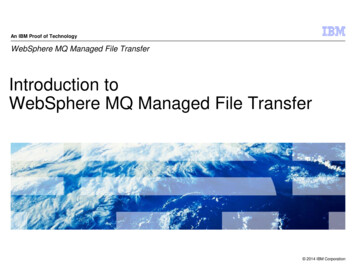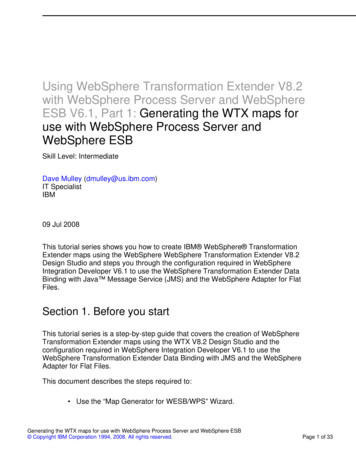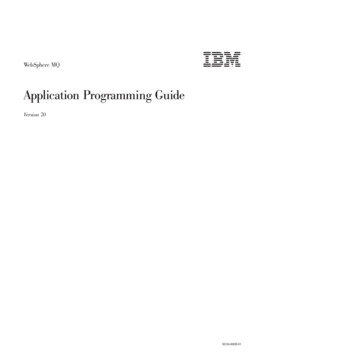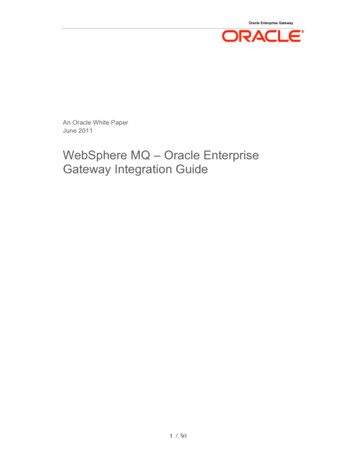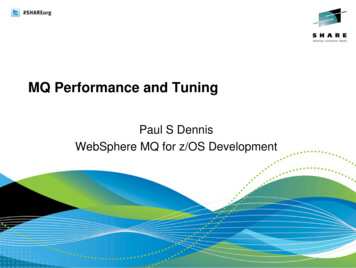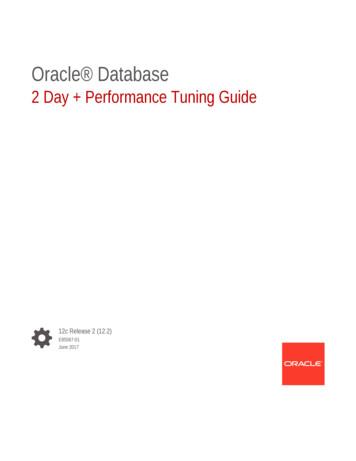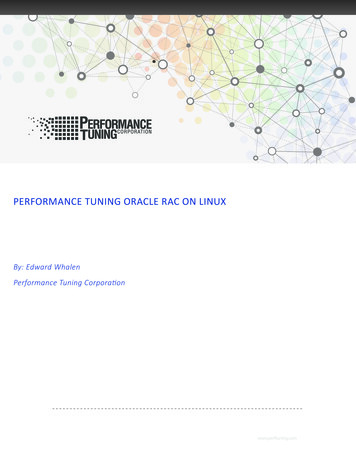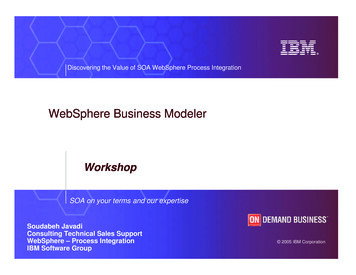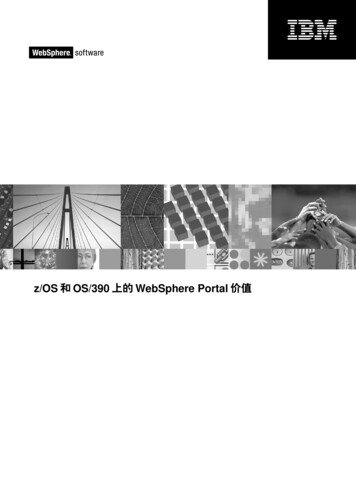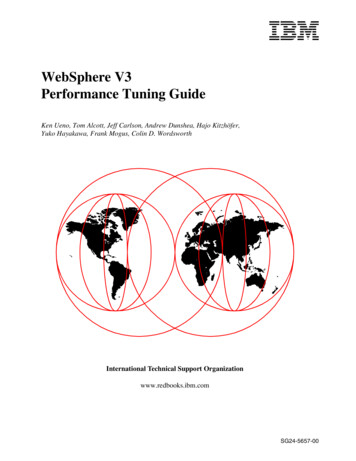
Transcription
WebSphere V3Performance Tuning GuideKen Ueno, Tom Alcott, Jeff Carlson, Andrew Dunshea, Hajo Kitzhöfer,Yuko Hayakawa, Frank Mogus, Colin D. WordsworthInternational Technical Support Organizationwww.redbooks.ibm.comSG24-5657-00
International Technical Support OrganizationWebSphere V3Performance Tuning GuideMarch 2000SG24-5657-00
Take Note!Before using this information and the product it supports, be sure to read the general information in Appendix B,“Special notices” on page 185.First Edition (March 2000)This edition applies to: IBM WebSphere Application Server Version 3.02 IBM HTTP Server Version 1.3.6.2 IBM Java Development Kit Version 1.1.6.9for use with the AIX V4.3.2 operating system.Comments may be addressed to:IBM Corporation, International Technical Support OrganizationDept. HZ8 Building 678P.O. Box 12195Research Triangle Park, NC 27709-2195When you send information to IBM, you grant IBM a non-exclusive right to use or distribute the information in anyway it believes appropriate without incurring any obligation to you. Copyright International Business Machines Corporation 2000. All rights reserved.Note to U.S Government Users - Documentation related to restricted rights - Use, duplication or disclosure is subject to restrictionsset forth in GSA ADP Schedule Contract with IBM Corp.
ContentsPreface . . . . . . . . . . . . . . . . . . . . . . . . . . . . . . . . . . . . . . . . . . . . . . . . . . . . . . viiThe team that wrote this redbook . . . . . . . . . . . . . . . . . . . . . . . . . . . . . . . . . . . . . . viiComments welcome . . . . . . . . . . . . . . . . . . . . . . . . . . . . . . . . . . . . . . . . . . . . . . . . . ixChapter 1. Overview of WebSphere Application Server V31.1 WebSphere Application Server V3 . . . . . . . . . . . . . . . . . .1.2 Standard Edition . . . . . . . . . . . . . . . . . . . . . . . . . . . . . . . .1.3 Advanced Edition . . . . . . . . . . . . . . . . . . . . . . . . . . . . . . . .1. .1. .3. .3Chapter 2. Performance tuning approach . . . . . . . . . . . . . . . .2.1 WebSphere Application Server V3 topologies . . . . . . . . . . . .2.1.1 Topology 1: single machine . . . . . . . . . . . . . . . . . . . . . .2.1.2 Topology 2: separating the database server from WAS .2.1.3 Topology 3: multiple application servers . . . . . . . . . . . .2.1.4 Topology 4: advanced topology . . . . . . . . . . . . . . . . . . .2.1.5 Our test application . . . . . . . . . . . . . . . . . . . . . . . . . . . .2.2 Network and hardware configuration . . . . . . . . . . . . . . . . . . . .7. .8. .8. .9.10.10.11.13Chapter 3. AIX TCP/IP tuning . . . . . . . . . . . . . . . . . . . . . . . . . . . . . . . . . . . .153.1 Network tuning with no command . . . . . . . . . . . . . . . . . . . . . . . . . . . . . . .153.2 Tuning parameter summary . . . . . . . . . . . . . . . . . . . . . . . . . . . . . . . . . . .19Chapter 4. Web Server: IBM HTTP Server4.1 Process handling . . . . . . . . . . . . . . . . .4.2 Connection . . . . . . . . . . . . . . . . . . . . . .4.3 Resource usage . . . . . . . . . . . . . . . . . .4.4 Name resolution . . . . . . . . . . . . . . . . . .4.5 Fast Response Cache Accelerator . . . .4.6 APAR for Web server performance . . . . Copyright IBM Corp. 20001.3.6.21.21.22.23.24.24.27Chapter 5. WebSphere Engine . . . . . . . . . . . . . . . . . . . . . . . . . . . .5.1 JVM . . . . . . . . . . . . . . . . . . . . . . . . . . . . . . . . . . . . . . . . . . . . . .5.1.1 Selecting a JVM . . . . . . . . . . . . . . . . . . . . . . . . . . . . . . . . .5.1.2 Tuning the JVM . . . . . . . . . . . . . . . . . . . . . . . . . . . . . . . . . .5.1.3 JVM heap size . . . . . . . . . . . . . . . . . . . . . . . . . . . . . . . . . .5.1.4 JIT. . . . . . . . . . . . . . . . . . . . . . . . . . . . . . . . . . . . . . . . . . . .5.1.5 Garbage collection . . . . . . . . . . . . . . . . . . . . . . . . . . . . . . .5.1.6 Java stack and native thread stack size . . . . . . . . . . . . . . .5.2 Transport queue . . . . . . . . . . . . . . . . . . . . . . . . . . . . . . . . . . . . .5.2.1 Queue type: OSE . . . . . . . . . . . . . . . . . . . . . . . . . . . . . . . .5.2.2 Transport type . . . . . . . . . . . . . . . . . . . . . . . . . . . . . . . . . . .5.2.3 Maximum connections. . . . . . . . . . . . . . . . . . . . . . . . . . . . .5.2.4 Queue type for servlet redirector . . . . . . . . . . . . . . . . . . . . .5.3 Servlets Auto Reload . . . . . . . . . . . . . . . . . . . . . . . . . . . . . . . . .5.4 EJB Container. . . . . . . . . . . . . . . . . . . . . . . . . . . . . . . . . . . . . . .5.4.1 Cache size . . . . . . . . . . . . . . . . . . . . . . . . . . . . . . . . . . . . .5.4.2 Cache preferred limit . . . . . . . . . . . . . . . . . . . . . . . . . . . . . .5.4.3 Cache absolute limit . . . . . . . . . . . . . . . . . . . . . . . . . . . . . .5.4.4 Cache cleanup interval . . . . . . . . . . . . . . . . . . . . . . . . . . . .5.4.5 Option A and option C caching performance considerations5.4.6 Number of containers . . . . . . . . . . . . . . . . . . . . . . . . . . . . 2.43.43.44.45iii
5.5 ORB . . . . . . . . . . . . . . . . . . . . . . . . . . . . . . . . . . . . . . . . . . . . . . . . . . . . 45Chapter 6. Security . . . . . . . . . .6.1 WebSphere security overview6.2 Configuring security . . . . . . . .6.2.1 Enabling security . . . . . .6.2.2 Security cache timeout. .6.2.3 SSL V3 timeout . . . . . . .6.3 The invoker servlet . . . . . . . .iv.49495151525354Chapter 7. Database tuning . . . . . . . . . . . .7.1 The WebSphere administrative repository7.1.1 Serious event reporting . . . . . . . . . .7.2 DataSource object settings . . . . . . . . . . .7.2.1 Connection pooling . . . . . . . . . . . . .7.3 Prepared statements . . . . . . . . . . . . . . . .7.3.1 Prepared statement cache . . . . . . . .7.3.2 Prepared statement key cache. . . . .7.4 UDB configuration . . . . . . . . . . . . . . . . . .7.4.1 Buffpage . . . . . . . . . . . . . . . . . . . . .7.4.2 Applheapsz . . . . . . . . . . . . . . . . . . .7.4.3 Pckcachesz . . . . . . . . . . . . . . . . . . .7.4.4 Maxappls . . . . . . . . . . . . . . . . . . . . .7.4.5 Dft degree. . . . . . . . . . . . . . . . . . . .7.4.6 Locklist . . . . . . . . . . . . . . . . . . . . . .7.4.7 Maxlocks . . . . . . . . . . . . . . . . . . . . .7.4.8 Locktimeout . . . . . . . . . . . . . . . . . . .7.4.9 Maxagents . . . . . . . . . . . . . . . . . . . .575759616164646566677071717172727373Chapter 8. Session management . . . . . . . . .8.1 Session information . . . . . . . . . . . . . . . . . .8.2 Keeping session information in memory . .8.3 Persistent sessions . . . . . . . . . . . . . . . . . .8.3.1 Database/Datasource configuration . .8.3.2 Session Manager configuration . . . . .8.4 Tuning the Session Manager . . . . . . . . . . .8.4.1 The Invalidate Time setting . . . . . . . .8.4.2 Monitor and estimate Invalidate Time.8.4.3 Tuning parameters on the Tuning tab8.4.4 Multirow sessions . . . . . . . . . . . . . . .8.4.5 Using cache . . . . . . . . . . . . . . . . . . . .8.4.6 Using manual update . . . . . . . . . . . . .8.4.7 Using native access . . . . . . . . . . . . . .8.4.8 Allow overflow . . . . . . . . . . . . . . . . . .8.4.9 Base memory size . . . . . . . . . . . . . . .75757576767677777879808182828283Chapter 9. Performance test tools . .9.1 WebStone . . . . . . . . . . . . . . . . . . .9.2 AKtools . . . . . . . . . . . . . . . . . . . . .9.3 Apache Bench . . . . . . . . . . . . . . . .9.4 Rational Suite Performance Studio9.5 JMeter . . . . . . . . . . . . . . . . . . . . . .9.6 WebLoad . . . . . . . . . . . . . . . . . . . .9.7 LoadRunner. . . . . . . . . . . . . . . . . .8585858687878888WebSphere V3 Performance Tuning Guide.
Chapter 10. Monitoring tools . . . . . . . . . . . . . . . . . . . . . . . . . . . .10.1 WebSphere Application Server Resource Analyzer . . . . . . . . .10.1.1 Enterprise beans . . . . . . . . . . . . . . . . . . . . . . . . . . . . . . .10.1.2 Servlets . . . . . . . . . . . . . . . . . . . . . . . . . . . . . . . . . . . . . .10.1.3 Sessions . . . . . . . . . . . . . . . . . . . . . . . . . . . . . . . . . . . . .10.1.4 System Resources . . . . . . . . . . . . . . . . . . . . . . . . . . . . .10.1.5 DB pools . . . . . . . . . . . . . . . . . . . . . . . . . . . . . . . . . . . . .10.2 AIX performance tools. . . . . . . . . . . . . . . . . . . . . . . . . . . . . . .10.3 Managing memory resources . . . . . . . . . . . . . . . . . . . . . . . . .10.3.1 Monitoring memory with vmstat . . . . . . . . . . . . . . . . . . . .10.3.2 Monitoring memory with sar . . . . . . . . . . . . . . . . . . . . . .10.3.3 Monitoring memory with lsps . . . . . . . . . . . . . . . . . . . . . .10.3.4 Monitoring memory with ps . . . . . . . . . . . . . . . . . . . . . . .10.3.5 Monitoring memory with svmon . . . . . . . . . . . . . . . . . . . .10.4 Managing CPU resources . . . . . . . . . . . . . . . . . . . . . . . . . . . .10.4.1 Monitoring the CPU with vmstat . . . . . . . . . . . . . . . . . . .10.4.2 Monitoring the CPU with sar . . . . . . . . . . . . . . . . . . . . . .10.4.3 Monitoring the CPU with time . . . . . . . . . . . . . . . . . . . . .10.4.4 Checking active CPUs using cpu state . . . . . . . . . . . . . .10.5 Managing network resources . . . . . . . . . . . . . . . . . . . . . . . . .10.5.1 Monitoring the network with netstat . . . . . . . . . . . . . . . . .10.6 Tuning methodology example with changing JVM parameters10.6.1 Case 1: -mx64m . . . . . . . . . . . . . . . . . . . . . . . . . . . . . . .10.6.2 Case 2: -ms32m, -mx64m . . . . . . . . . . . . . . . . . . . . . . . .10.6.3 Case 3: -ms64m, -mx64m . . . . . . . . . . . . . . . . . . . . . . . . .89. .89. .91. .96. 4.115.115.116.116.119.119.124.129Chapter 11. WebSphere Application Server Site Analyzer . . . . . .11.1 What is WebSphere Application Server Site Analyzer? . . . . . . .11.2 Why do I need WebSphere Application Server Site Analyzer? .11.2.1 Features of WebSphere Application Server Site Analyzer .11.2.2 Content analysis . . . . . . . . . . . . . . . . . . . . . . . . . . . . . . . .11.2.3 Usage analysis . . . . . . . . . . . . . . . . . . . . . . . . . . . . . . . . .11.2.4 Visualization and reports . . . . . . . . . . . . . . . . . . . . . . . . . .11.2.5 Usability . . . . . . . . . . . . . . . . . . . . . . . . . . . . . . . . . . . . . .11.2.6 Technology . . . . . . . . . . . . . . . . . . . . . . . . . . . . . . . . . . . .11.2.7 Client/server configuration. . . . . . . . . . . . . . . . . . . . . . . . .133.133.134.135.135.136.137.138.139.140Chapter 12. AFS performance tuning guide . . . . . .12.1 Overview . . . . . . . . . . . . . . . . . . . . . . . . . . . . . . .12.2 Communications with the fileserver process . . . .12.3 Commonly used parameters . . . . . . . . . . . . . . . .12.4 Overview of AFS 3.5 File Server changes . . . . . .12.5 AFS 3.5 File Server performance improvements .12.5.1 POSIX threads . . . . . . . . . . . . . . . . . . . . . .12.5.2 RX slow start . . . . . . . . . . . . . . . . . . . . . . . .12.5.3 File descriptor caching . . . . . . . . . . . . . . . .12.5.4 Reduced lock contention . . . . . . . . . . . . . . .12.5.5 Overload processing . . . . . . . . . . . . . . . . . .12.5.6 Buffer management . . . . . . . . . . . . . . . . . . .12.6 AFS 3.5 File Server parameter changes . . . . . . .12.7 Scenarios . . . . . . . . . . . . . . . . . . . . . . . . . . . . . .12.7.1 Scenario #1 . . . . . . . . . . . . . . . . . . . . . . . . .12.7.2 Scenario #2 . . . . . . . . . . . . . . . . . . . . . . . . 51.152.152.154.v
12.7.3 Scenario #3 . . . . . . . . . . . . . . . . . . . . . . . . . . .12.7.4 Scenario #4 . . . . . . . . . . . . . . . . . . . . . . . . . . .12.8 Debugging tools and example output . . . . . . . . . . . .12.8.1 RXDEBUG incorporated in the meltdown script12.8.2 tcpdump. . . . . . . . . . . . . . . . . . . . . . . . . . . . . .12.8.3 netstat . . . . . . . . . . . . . . . . . . . . . . . . . . . . . . .12.9 Summary . . . . . . . . . . . . . . . . . . . . . . . . . . . . . . . . .157158160160162164165Appendix A. TCP/IP overview and tuning . . . . . . . . . . . . . . . . . . . . . . . . . . . 167A.1 TCP/IP overview . . . . . . . . . . . . . . . . . . . . . . . . . . . . . . . . . . . . . . . . . . . . . . 167A.2 Maximum Transmission Unit (MTU). . . . . . . . . . . . . . . . . . . . . . . . . . . . . . . .169A.3 Adapter queue size . . . . . . . . . . . . . . . . . . . . . . . . . . . . . . . . . . . . . . . . . . . . 169A.3.1 Transmit and receive queues. . . . . . . . . . . . . . . . . . . . . . . . . . . . . . . . . 170A.3.2 Adapter queue settings . . . . . . . . . . . . . . . . . . . . . . . . . . . . . . . . . . . . . 171A.3.3 Adapter tuning recommendations . . . . . . . . . . . . . . . . . . . . . . . . . . . . . 172A.4 TCP maximum segment size (MSS) . . . . . . . . . . . . . . . . . . . . . . . . . . . . . . . 172A.4.1 Subnetting and the subnetsarelocal. . . . . . . . . . . . . . . . . . . . . . . . . . . . 172A.4.2 TCP data flow . . . . . . . . . . . . . . . . . . . . . . . . . . . . . . . . . . . . . . . . . . . . 174A.5 TCP sliding window . . . . . . . . . . . . . . . . . . . . . . . . . . . . . . . . . . . . . . . . . . . . 175A.6 Socket layer . . . . . . . . . . . . . . . . . . . . . . . . . . . . . . . . . . . . . . . . . . . . . . . . . . 177A.7 Communication subsystem memory management . . . . . . . . . . . . . . . . . . . . 178A.8 Interface specific network options for AIX 4.3.3 . . . . . . . . . . . . . . . . . . . . . . . 181A.8.1 Implementation overview . . . . . . . . . . . . . . . . . . . . . . . . . . . . . . . . . . . . 182A.8.2 How to use the new options . . . . . . . . . . . . . . . . . . . . . . . . . . . . . . . . . . 182A.8.3 References for the ISNO . . . . . . . . . . . . . . . . . . . . . . . . . . . . . . . . . . . . 183Appendix B. Special notices . . . . . . . . . . . . . . . . . . . . . . . . . . . . . . . . . . . . . .185Appendix C. Related publications . .C.1 IBM Redbooks . . . . . . . . . . . . . . . . .C.2 IBM Redbooks collections . . . . . . . .C.3 Other resources . . . . . . . . . . . . . . . .C.4 Referenced Web sites . . . . . . . . . . . . . . . 187. . . . . 187. . . . . 187. . . . . 187. . . . . 188How to get IBM Redbooks . . . . . . . . . . . . . . . . . . . . . . . . . . . . . . . . . . . . . 189IBM Redbooks fax order form . . . . . . . . . . . . . . . . . . . . . . . . . . . . . . . . . . . . . . . . 190Index . . . . . . . . . . . . . . . . . . . . . . . . . . . . . . . . . . . . . . . . . . . . . . . . . . . . . . 191IBM Redbooks review . . . . . . . . . . . . . . . . . . . . . . . . . . . . . . . . . . . . . . . . . 197viWebSphere V3 Performance Tuning Guide
PrefaceThis redbook will help you to design and configure WebSphere Application ServerV3.02 for AIX, Solaris, and Windows NT for better performance. The main tuningobjectives for WebSphere are to improve performance, response time, andresource utilization.This redbook gives some general recommendations and describes specific tuningmethodologies. It provides hints and tips on the various factors and variables thatcan enhance the performance of WebSphere including AIX networks and IBMHTTP Server performance tuning. We introduce performance test tools andmonitoring tools. WebSphere tuning methodology examples are included. Thisredbook also contains an overview of WebSphere Site Analyzer. We also providea performance tuning guide for AFS, which is a part of WebSphere PerformancePack.Some knowledge of WebSphere Application Server V3.02, DB2 UDB, and AIXare assumed. Note that in this redbook we will not discuss the basicconfigurations of WebSphere, DB2 UDB, or AIX.The team that wrote this redbookThis redbook was produced by a team of specialists from around the worldworking at the International Technical Support Organization, Raleigh Center.Ken Ueno is an advisory International Technical Support Representative at theInternational Technical Support Organization, Raleigh Center. He managesresidencies and produces redbooks. Before joining the ITSO, he worked inInternet Systems, IBM Japan Systems Engineering Co., Ltd in Japan as an I/TSpecialist. He can be reached at kenueno@us.ibm.com.Tom Alcott is an advisory I/T specialist in the United States. He has been amember of the World Wide WebSphere Technical Sales Support team since itsinception. Before he started working with WebSphere, he was a systemsengineer for IBM’s Transarc Lab supporting TXSeries. His background includesover 18 years of application design and development on both mainframe-basedand distributed systems. He has written and presented extensively on a numberof WebSphere runtime and security issues.Jeff Carlson is a Staff Software Engineer on the AFS/WSPP team at the IBMTransarc Lab in the United States. He has over 10 years of experience in thesupport of various mainframe, PC/LAN, and UNIX workstation products. Jeffgraduated Magna Cum Laude from Robert Morris College with a Bachelor'sdegree in Business Administration. At the IBM Transarc Lab, he has writtenextensively on AFS performance tuning.Andrew Dunshea is a Performance Analyst from IBM New Zealand. He has 10years of experience in application development. His areas of expertise includeobject-oriented software development and analysis, systems programming, andperformance analysis.Dr. Hajo Kitzhöfer is an Advisory International Technical Support Organization(ITSO) Specialist for RS/6000 SP at the Poughkeepsie Center. His areas of Copyright IBM Corp. 2000vii
expertise include RS/6000 SP, SMP, and Benchmarks. He now specializes in SPSystem Management, SP Performance Tuning, and SP hardware.Yuko Hayakawa is an I/T Specialist in Japan. she has four years of experience inthe e-commerce field. She has worked at IBM for 4 years. Yuko has writtenextensively on database tuning and session management.Frank Mogus is a Systems Consultant in Canada. He has several years of UNIXexperience and has worked with The Braegen Group for four years.Colin D. Wordsworth is a software engineer in Australia. He has 16 years ofexperience in applications development. He has been with IBM for the last fiveyears, and is currently involved in setting up the e-business centre for excellencein Western Australia.Thanks to the following people from the International Technical SupportOrganization, Raleigh Center:Carla SadtlerGail ChristensenShawn WalshJohn GanciBarry NusbaumMargaret TicknorMike HaleyThanks to the following IBM employees:Ruth Willenborg, Manager, WebSphere Performance, RaleighChris Forte, WebSphere Performance, RaleighRon Bostick, WebSphere Performance, RaleighCharlie Bradley, WebSphere Performance, RaleighJerry Cuomo, Manager, WebSphere Performance and Security, RaleighGraeme N. Dixon, STSM, WebSphere Development, IBM Transarc LabJason R McGee, WebSphere Development, RaleighSongquan Liu, WebSphere Development, IBM Transarc LabTianyu Jiang, WebSphere Development, IBM Transarc LabCindy Tipper, WebSphere Development, IBM Transarc LabChris Newbold, WebSphere Development, IBM Transarc LabChriss Stephens, WebSphere Development, IBM Transarc LabGabe Montero, WebSphere Development, RaleighAllan Dickson, WebSphere Development, RaleighLinh Nguyen, Project Manager, IBM HTTP Server Development, RaleighDavid Allen, IBM HTTP Server Development, RaleighTom Hartrick, Manager, Site Analyzer Development, RaleighGopi Attaluri, DB2 Performance Team, TorontoSteve Schormann, DB2 Performance Team, TorontoRichard Nesbitt, Special Events Development, RaleighSteve King, System Administration, RaleighMarco Pistoia, T.J. Watson ResearchTetsuya Shirai, ITSO San Jose CenterJoanne Luedtke, Manager, ITSO Austin CenterviiiWebSphere V3 Performance Tuning Guide
Comments welcomeYour comments are important to us!We want our redbooks to be as helpful as possible. Please send us yourcomments about this or other redbooks in one of the following ways: Fax the evaluation form found in “IBM Redbooks review” on page 197 to thefax number shown on the form. Use the online evaluation form found at http://www.redbooks.ibm.com/ Send your comments in an internet note to redbook@us.ibm.comix
xWebSphere V3 Performance Tuning Guide
Chapter 1. Overview of WebSphere Application Server V3This chapter gives an overview of the WebSphere Application Server V3, whichcomes in three editions: WebSphere Application Server, Standard Edition WebSphere Application Server, Advanced Edition WebSphere Application Server, Enterprise EditionThe Enterprise Edition builds on the Advanced Edition. It combines the TXSeriesand Component Broker with the Advanced Edition. The Enterprise Edition is notcovered in this redbook.1.1 WebSphere Application Server V3Our discussion will cover two editions of WebSphere: Standard and Advanced.Both products are based on and support key open-industry standards such asHyperText Transfer Protocol (HTTP), HyperText Markup Language (HTML),Extensible Markup Language (XML), Secure Sockets Layer (SSL), Java,JavaBeans, Common Object Request Broker Architecture (CORBA), LightweightDirectory Access Protocol (LDAP), and most importantly the following EnterpriseJava APIs: Enterprise JavaBeans (EJB) technology is a reusable Java component forconnectivity and transactions (EJB support is provided only in the AdvancedEdition). Java Server Pages (JSP) represent inline Java code scripted within Webpages. Java Servlets are used in building and deploying server-side Javaapplications. Java Interface Definition Language (JIDL), is used to connect to CORBAobjects and applications. Java DataBase Connectivity (JDBC) is for connections to relationaldatabases. WebSphere supports JDBC within its Connection Manager andwithin EJBs, for distributed database interactions and transactions. Java Messaging Service (JMS) is to be supported via MQSeries forasynchronous messaging and queuing and for providing an interface. Java Transaction Service (JTS) and Java Transaction API (JTA) are low-levelAPIs for interacting with transaction processing systems and relationaldatabases, respectively. WebSphere uses these within EJBs for supportingdistributed transactions. Java Naming and Directory Interface (JNDI) is for communicating withdirectories and naming systems and is used in WebSphere Application Serverto look up existing EJBs and interact with directories. Java Remote Method Invocation over Internet Inter-ORB Protocol (RMI/IIOP)is for communicating with other ORBs (Object Request Brokers) andCORBA-compliant applications. Copyright IBM Corp. 20001
Version 3 of WebSphere introduces a new runtime architecture for theWebSphere Application Server. This runtime architecture is divided into thefollowing components: Administration Server (“adminserver”) - The adminserver is the SystemsManagement runtime component of WebSphere. The adminserver isresponsible for runtime management, security, transaction coordination,and workload management. In most cases (exceptions will be outlinedlater) the adminserver runs on all nodes in a WebSphere Administrativedomain and controls the interaction between each node and applicationserver process in the domain. Administrative Console (“adminclient”) - The adminclient is the graphicaluser interface used for administration of a WebSphere Administrativedomain. The adminclient can run on one of the nodes that the adminserveris running on, or it can be a remote node that attaches to a runningadminserver. System Configuration Repository - WebSphere stores all runtimeconfiguration information in a persistent repository. In Standard Edition thisrepository can be either UDB V5.2, UDB V6.1, Oracle 8.05, or InstantDB(which ships with the Standard Edition). Advanced Edition supports UDBand Oracle as noted for Standard Edition. This repository can either existon the same physical server as WebSphere or can be configured on aremote server. Application Server - WebSphere V3 introduces the notion of an applicationserver process that is separate from the runtime server (adminserver). Ineither WebSphere Standard or Advanced Edition, you can define multipleapplication servers, each of which has its own JVM. These applicationservers in turn can have either a servlet engine, EJB container, or bothdefined to them depending on application requirements.The components of WebSphere V3 are depicted nistrationClientAdministrationServerDBFigure 1. WebSphere components2WebSphere V3 Performance Tuning Guide
1.2 Standard EditionWebSphere Standard Edition is a single system, extremely easy-to-use Webapplication server. Programmers developing applications think that they areimplementing extended HTML content. The content/page styles include: Static HTML (HTML, .gif, .wav, etc.) HTML with imbedded client-side scripts, for example JavaScript Java Server Pages (JSP)WebSphere Standard Edition’s objective is to be a simple, easy-to-use butcomplete solution for building an active Web site and basic Web applications thatintegrate with databases.WebSphere Standard Edition does not provide the Work Load Management(WLM) functionality that is available in WebSphere Advanced Edition, but doesallow for multiple JVMs on a single physical server. WebSphere Standard Editionis also limited to a single node/machine unlike WebSphere Advanced Edition.These JVMs can be mapped to multiple virtual hosts on a single HTTP server toprovide support for hosting multiple Web sites on a single application server. Thisis useful for Internet service providers (ISPs) or for a company wishing to host theInternet and Intranet Web site on a single server, since WebSphere StandardEdition has single system application server scalability, achieved through the useof a product such as Network Dispatcher, which is a part of WebSpherePerformance Pack. An example configuration is shown in Figure 2.Application Server NodeHTTPServerWebSphereApplication ServerWeb BrowserNetworkDispatcherWebSphereApplication ServerHTTPServerHTTPServerWebSphereApplication ServerDBCICSEnterprise DataFigure 2. WebSphere Application Server with Network Dispatcher1.3 Advanced EditionWebSphere Advanced Edition extends the WebSphere Standard Edition’sfunctions across multiple machines to provide complete support for developingnew high-performance, scalable and available, transactional Web-drivenapplications. WebSphere Advanced Edition focuses on new applications (JSPsand EJBs) that access relational databases for persistent state data.Chapter 1. Overview of WebSphere Application Server V33
WebSphere Advanced Edition also supports distributed system management fornetworks and clusters of WebSphere Advanced Edition systems, and supports ashared name and security between networks and clusters of WebSphereAdvanced Edition systems.In an object-oriented distributed computing environment, clients must have amechanism to locate and identify the objects as if the clients and objects were allon the same machine. A naming service provides this mechanism. In the EJBserver environment, the Java Naming and Directory Interface (JNDI) is used toprovide a common front-end to the naming service.JNDI provides naming and directory functionality to Java applications, but the APIis independent of any specific implementation of a naming and directory service.This independence ensures that different naming and directory services can
redbook also contains an overview of WebSphere Site Analyzer. We also provide a performance tuning guide for AFS, which is a part of WebSphere Performance Pack. Some knowledge of WebSphere Application Server V3.02, DB2 UDB, and AIX are assumed. Note that in this redbook we will not discuss the basic configurations of WebSphere, DB2 UDB, or AIX.

